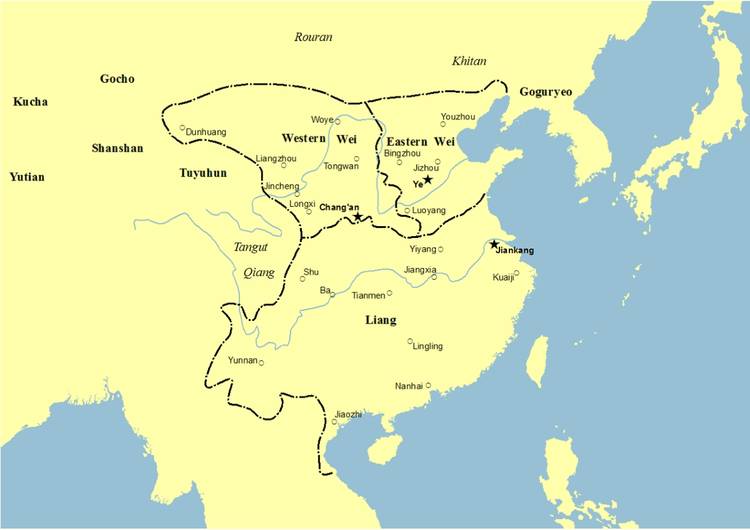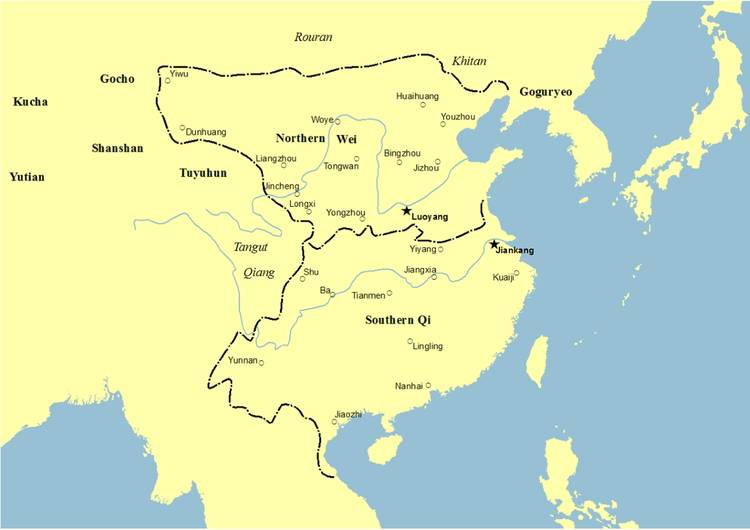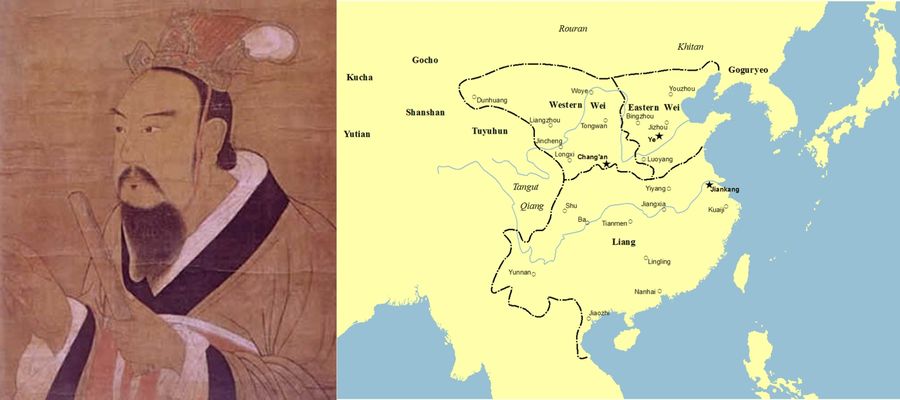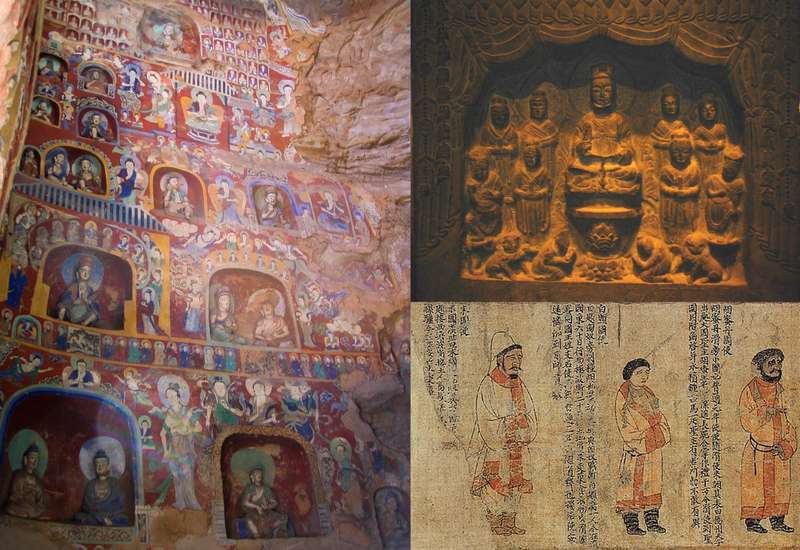Chinese Dynasty: Northern and Southern Dynasties (420-589 CE)
The Northern and Southern Dynasties (南北朝, Nán Běi Cháo), lasting from 420 to 589 CE, marked a period of political division in China following the Sixteen Kingdoms (十六国, 304-439 CE) and Eastern Jin Dynasty (东晋, 317-420 CE). This period witnessed the division of China into multiple rival dynasties, with the north under the control of non-Han Chinese regimes, while the south remained primarily under the influence of native Chinese rulers. It is sometimes considered a part of the broader Six Dynasties period (六朝, Liù Cháo, 220-589 CE).
Despite the turmoil and conflicts, this era witnessed a flourishing of arts, culture, technological advancements, and the widespread influence of Mahayana Buddhism (大乘佛教) and Daoism (道教). It also saw a significant migration of the Han people (汉族) to the southern regions, and it concluded with the reunification of China under Emperor Wen of the Sui Dynasty (隋文帝).
History
The Northern and Southern Dynasties (南北朝) began in 420 CE when Liu Yu (刘裕) established the Liu Song (Southern Song) Dynasty (刘宋/南朝宋) and ended in 589 CE when the Sui Dynasty (隋朝) conquered Chen (南陈), unifying the entire country. During the Northern and Southern Dynasties era, China was in a prolonged state of division between the southern and northern regions.
The Southern Dynasties (南朝, 420-589 CE) inherited the legacy of the Eastern Jin Dynasty (东晋) and consisted of four dynasties: Liu Song (南朝宋/刘宋), Southern Qi (南朝齐/萧齐), Liang (南朝梁/ 萧梁), and Chen (南朝陈/南陈). The capitals of these dynasties were all located in Jiankang (建康, present-day Nanjing, Jiangsu Province).
The Northern Dynasties (北朝, 439-581 CE) emerged from the Sixteen Kingdoms (十六国) and consisted of five dynasties: Northern Wei (北魏), Eastern Wei (东魏) and Western Wei (西魏), Northern Qi (北齐) and Northern Zhou (北周). Northern Wei first unified the north, but eventually split into Eastern and Western Wei, and Northern Qi replaced Eastern Wei, followed by Northern Zhou overthrowing Western Wei. Finally, Northern Zhou conquered Northern Qi.
In the end, Yang Jian (杨坚) usurped Northern Zhou and established Sui Dynasty (隋朝), which later conquered Chen in the south, finally unifying the entire country.
The table below summarizes the different periods and dynasties during the Northern and Southern Dynasties period.
| Northern and Southern Dynasties 南北朝 (420-589 CE) |
| ||||
| Northern Dynasties 北朝 (439-581 CE) | Southern Dynasties 南朝 (420-589 CE) |
| |||
| Start | Northern Wei (北魏) conquered Northern Liang (北凉) in 439 CE | Liu Yu (刘裕) usurped Eastern Jin (东晋) establishing Liu Song (刘宋) in 420 CE |
| ||
| End | Yang Jian (杨坚) usurped Northern Zhou (北周) establishing the Sui Dynasty (隋朝) in 581 CE | The Sui Dynasty (隋朝) conquered Chen (南陈) in 589 CE |
| ||
| State/ Dynasty | Northern Wei 北魏 (386-535 CE) | Liu Song 刘宋 (420-479 CE) | |||
| Southern Qi 萧齐 (479-502 CE) | |||||
| Liang 萧梁 (502-557 CE) | |||||
| Western Wei 西魏 (535-557 CE) | Eastern Wei 东魏 (534-550 CE) |
| |||
| Northern Zhou 北周 (557-581 CE) | Northern Qi 北齐 (550-577 CE) | Western Liang 西梁 (555-587 CE) | Chen 南陈 (557-589 CE) |
| |
Northern Dynasties (439-581 CE)
The Northern Dynasties coexisted with the Southern Dynasties during this period in Chinese history, which had five dynasties. Among them, the Northern Wei (北魏), Eastern Wei (东魏), Western Wei (西魏), and Northern Zhou (北周) were established by the Xianbei (鲜卑) ethnic group, while the Northern Qi (北齐) was founded by Han Chinese who underwent Xianbei assimilation.
Northern Wei (386-535 CE)

Map of Northern Wei and Liu Song in 460 CE
During the Sixteen Kingdoms period (十六国), the Tuoba family (拓跋氏) of the Xianbei ethnic group (鲜卑) ruled the state of Dai (代国). After the Former Qin (前秦) collapsed, Tuoba Gui (拓跋珪), Emperor Daowu of Northern Wei (北魏道武帝), revived the fortunes of the Tuoba clan and established the Northern Wei Dynasty (北魏), with its capital at Shengle (盛乐).
Under the successive rule of Emperors Daowu, Mingyuan (明元帝), and Taiwu (太武帝), Northern Wei expanded its territory.
Emperor Mingyuan conquered Liu Song's (刘宋) province of Henan (河南地, not the same as the present-day Henan Province), but his reign was short-lived.
Emperor Taiwu, his son, further strengthened Northern Wei through campaigns against Liu Song and the Rouran (柔然). He eventually united northern China by defeating Northern Liang (北凉) and other kingdoms in 439 CE, and the Northern Dynasties period officially began.
However, ongoing Rouran harassment redirected their attention from further southern expeditions.
In 450 CE, Emperor Taiwu initiated an attack on Liu Song, initially achieving dominance but suffering heavy casualties. They subsequently returned north after plundering. Influenced by his prime minister Cui Hao (崔浩), Emperor Taiwu proscribed Buddhism and began a series of persecutions known as one of the Three Disasters of Wu (三武灭佛). His later years were marked by cruel punishments, leading to his death at the hands of the eunuch Zong Ai (宗爱) in 452 CE. This triggered a period of turmoil that ended with the ascension of Emperor Wencheng (文成帝) later that year.
In the early years of the Northern Wei Dynasty, the ruling Xianbei tribes strictly maintained social distinctions between themselves and the Han Chinese population. Although Han individuals were employed in bureaucratic roles and tax collection, they were largely excluded from higher positions of power. Han Chinese constituted the minority in regions where power centers were located.
During the reign of Emperor Xiaowen of Northern Wei (魏孝文帝, reigned 471-499 CE), significant social and cultural transformations took place in northern China. Emperor Xiaowen, born to a Xianbei father and a Han mother, embraced his dual Xianbei-Han identity.
In 493 CE, Emperor Xiaowen initiated a sinicization program, which aimed to assimilate the Xianbei elites into Han culture. This program included adopting Han clothing (while banning Xianbei clothing at court), learning the Han language (for those under the age of thirty), changing Xianbei family names to one-character Han surnames, and promoting intermarriage between high-ranking Xianbei and Han families.
Emperor Xiaowen also relocated the capital from Pingcheng (平城) to Luoyang (洛阳), an ancient imperial site that had served as the capital during the Eastern Han (东汉) and Western Jin (西晋) dynasties.
Northern Wei's Split: Eastern Wei (534-550 CE) and Western Wei (535-557 CE)

Map of Eastern Wei, Western Wei, and Liang in 541 CE
In 523 CE, a rebellion known as the Rebellion of the Six Garrisons (六镇之乱) erupted due to a food shortage far north of Luoyang. After suppressing the rebellion, the government made a mistake by deploying 200,000 surrendered rebels from the garrisons to Hebei, and one of their former officers organized another rebellion in 526-527 CE.
These conflicts stemmed from the growing divide between the ruling aristocracy, which was adopting Han-style sedentary practices, and the nomadic tribal armies that clung to their traditional steppe way of life.
Amidst the turmoil, a general from within the Northern Wei court betrayed his own leaders, throwing the empress dowager and the young emperor into the Yellow River. He then installed a puppet ruler to maintain his authority.
As tensions escalated among different factions in the north, Gao Huan (高欢) seized control of the eastern region and Luoyang (洛阳) in 534 CE, and established Eastern Wei (东魏) with Emperor Xiaojing of Eastern Wei (魏孝静帝) serving as a puppet ruler.
Meanwhile, Yuwen Tai (宇文泰) gained control of the western region and the traditional Chinese capital of Chang'an (长安) in 535 CE, establishing Western Wei (西魏) with Emperor Wen of Western Wei (西魏文帝) as the ruler. The Western regime was dominated by Sinicized nobles and their Han bureaucrats, while the Eastern regime was controlled by the traditional steppe tribes.
In the beginning, Eastern Wei had a stronger foundation inherited from the previous Northern Wei, giving them an advantage in military, economic, and cultural aspects. Gao Huan's control over Eastern Wei was supported by Xianbei and local aristocrats, and he prioritized Xianbei customs.
On the other hand, Yuwen Tai's Western Wei faced economic and cultural challenges compared to Southern Liang (南朝梁 or 萧梁) and Eastern Wei. Yuwen Tai implemented reforms, including reconciling the Han-Xianbei conflict and establishing a professional military force.
Despite Eastern Wei's initial advantages, they suffered defeats in battles against Western Wei. After a series of confrontations, Eastern Wei was overthrown by Gao Yang (高洋), who established Northern Qi (北齐) in 550 CE. Later, Western Wei was replaced by Northern Zhou (北周) under the rule of Yuwen Jue (宇文觉) in 557 CE.
Northern Qi (550-577 CE) and Northern Zhou (557-581 CE)

Map of Northern Qi, Northern Zhou, Liang, and Chen in 562 CE
Established in 550 CE by Emperor Wenxuan (齐文宣帝), the Northern Qi (北齐) had a developed economy and initially surpassed the Northern Zhou (北周) and Chen (南陈) dynasties. They inherited the main source of recruitment for the Northern Wei (北魏) army, which primarily came from the eastern territories. These areas consisted of local fortified settlements of both Han military families and settled steppe tribes.
However, Emperor Wenxuan's later rule became corrupt and brutal, leading to the decline of the Northern Qi. His successor, Emperor Xiaozhao (齐孝昭帝), saw a gradual recovery of the state's strength but died after two years of reign. Emperor Wucheng (齐武成帝), who succeeded him, indulged in pleasure and further weakened the Northern Qi.
The Northern Zhou (北周), established in 556 CE, prospered under Emperor Wu (周武帝, reigned 560-578 CE). During his reign, Emperor Wu pursued policies that protected the interests of the landlord class and adopted Confucianism as the ideological weapon. He strengthened the military force by recruiting Han Chinese soldiers and fostered cooperation between Han and Xianbei officers. He suppressed Buddhism and maintained diplomatic relations with the Turks and peace with the Southern Chen Dynasty.
Similar to Western Wei (西魏), Northern Zhou sought to revive Xianbei warrior culture as a reaction against Sinicization. They reintroduced Xianbei-style clothing, reverted Sinicized surnames to Xianbei names, and even assigned Xianbei surnames to Han officers. This "tribalization" policy aimed to convert a large number of Han Chinese army recruits into "Xianbei," and greatly strengthened the military power of the state.
In 577 CE, the Northern Zhou successfully defeated and conquered the Northern Qi, reunifying the northern region. However, their rule was short-lived, as they were overthrown by Yang Jian (杨坚) in 581 CE, who became Emperor Wen of the Sui Dynasty (隋文帝).
With a stronger military force and effective propaganda portraying the Chen ruler as a decadent ruler who had lost the Mandate of Heaven, the Sui Dynasty (隋朝) successfully conquered the southern region. This conquest marked the beginning of a new era of reunification throughout China under the short-lived Sui Dynasty (581-618 CE) and its successor, the long-lasting prosperous Tang Dynasty (唐朝, 618-907 CE).
Southern Dynasties (420-589 CE)
Chinese history entered a phase of division and confrontation between the North and the South regions in the early fourth century when the Western Jin (西晋) fell.
In the South, there were successions of different regimes including the Eastern Jin (东晋), Liu Song (刘宋), Southern Qi (南朝齐), Liang (南朝梁), and Chen (南陈). The capital of all these Southern regimes was consistently established in Jiankang (建康), except for a three-year period when the capital was briefly located in Jiangling (江陵, present-day Jingzhou) under Emperor Yuan of Liang (梁元帝).
The Southern regimes of Song (宋), Qi (齐), Liang (梁), and Chen (陈) are collectively referred to as the Southern Dynasties.
Liu Song (420-479 CE)

Left: a portrait of Liu Yu, Emperor Wu of Liu Song. Right: map of Liu Song and Northern Wei in 460 CE.
The Liu Song (刘宋 or 南朝宋) was the largest and strongest regime in terms of territory among the four Southern Dynasties, lasting for 60 years and spanning four generations and eight emperors.
Emperor Wu of the Song (宋武帝), Liu Yu (刘裕), rose to power in the aftermath of the chaos caused by Huan Xuan (桓玄) and launched two successful expeditions to reclaim territories in China. He usurped the throne of Eastern Jin (东晋), establishing the Liu Song Dynasty (刘宋).
Emperor Wu implemented reforms and advocated frugality, leading to a period of good governance. However, he neglected the education of the imperial family, resulting in conflicts between the emperor and the imperial relatives. After his death, his son Emperor Shao (宋少帝) was killed, and Emperor Wen (宋文帝) ascended to the throne. Emperor Wen brought stability by balancing power among the imperial family, aristocracy, and commoners. He advocated frugality and initiated prosperous governance.
However, military campaigns later suffered setbacks, and the dynasty's power declined. Emperor Wen was followed by Emperor Xiaowu (宋孝武帝) and Emperor Ming (宋明帝), who faced internal conflicts and a decline in national strength.
Ultimately, Xiao Daocheng (萧道成) usurped the throne, and established Southern Qi (南朝齐 or 萧齐) in 479 CE, marking the end of Liu Song.
Southern Qi (479-502 CE)

Map of Southern Qi and Northern Wei in 497 CE
The Southern Qi (萧齐 or 南朝齐) had a brief existence, lasting only 24 years. However, due to frequent power struggles, it went through three generations and seven emperors, with an average reign of three years per emperor, making it a regime with the fastest turnover of emperors in Chinese history.
Emperor Gao of Qi (齐高帝), Xiao Daocheng (萧道成), belonged to the clan Xiao of Lanling (兰陵萧氏), established Southern Qi and ruled with thrift but faced disdain from the aristocracy. After his reign, Emperor Wu of Qi (齐武帝) brought peace and good governance. However, his successors, Emperors Ming (齐明帝), Fei (齐废帝), and He (齐和帝) all faced internal conflicts and engaged in ruthless actions, leading to the downfall of Southern Qi.
Xiao Yan (萧衍) eventually usurped the throne and established the Liang Dynasty (萧梁 or 南朝梁) in 502 CE.
Liang (502-557 CE) and Western Liang (555-587 CE)

Left: a portrait of Xiao Yan, Emperor Wu of Liang. Right: map of Liang, Eastern and Western Wei in 541 CE.
The Liang Dynasty (萧梁 or 南朝梁) lasted for 56 years, with three generations and four emperors. Emperor Wu of Liang (梁武帝), Xiao Yan (萧衍), had the longest reign, ruling for nearly half a century.
Emperor Wu of Liang, an offshoot of the clan Xiao of Lanling (兰陵萧氏), was a legendary emperor who embraced Buddhism. He ruled with thrift and love for his people, ushering in a prosperous era for the early Liang Dynasty. However, his later years saw a decline due to indulgence and financial mismanagement.
Despite initial military victories, Emperor Wu's northern expeditions faced setbacks. The Liang Dynasty was later plagued by the Rebellion of Hou Jing (侯景之乱), leading to Emperor Wu's imprisonment and death.
However, Hou Jing's (侯景) reign was short-lived, as he was ultimately defeated by Prince Xiao Yi of Xiangdong (湘东王萧绎). However the Liang Dynasty fragmented, and different factions vied for power.
After Prince Xiao Yi succeeded as the Emperor Yuan of Liang (梁元帝) in Jiangling (江陵), Prince Xiao Ji of Wuling (武陵王萧纪), who held the region of Yizhou (益州), also declared himself emperor and attacked Jiangling. Emperor Yuan then sought help from Western Wei (西魏). Not long after, Xiao Ji was defeated, but Western Wei also took Yizhou.
The following year, Xiao Cha (萧詧) led the Western Wei army to take the opportunity to capture Jiangling, Emperor Yuan was killed, and the Western Wei made Xiao Cha a puppet ruler, controlling the western region of Liang, that is, the Western Liang (西梁 or 后梁, 555-587 CE).
Western Liang was a vassal state of Western Wei and the following Northern Zhou.
As for the Liang Dynasty, eventually, Chen Baxian (陈霸先) seized the throne, establishing the Chen Dynasty (南陈) in 557 CE.
Chen (557-589 CE)

Map of Chen, Western Liang, Northern Qi, and Northern Zhou in 562 CE
The Chen Dynasty (南陈 or 南朝陈) lasted for 32 years, with three generations and five emperors. Chen inherited the weaknesses of the declining Liang Dynasty, having a narrow territory, a weak population, and limited power. Furthermore, the rulers were highly corrupt, ultimately leading to their demise at the hands of powerful enemies from the North.
It's worth noting that among all dynasties in Chinese history, the Chen Dynasty (陈) is the only one where the dynasty name and the emperor's surname coincide.
Chen Baxian, Emperor Wu of Chen (陈武帝), ruled during a period of warfare and economic devastation in southern China. His successor, Emperor Wen of Chen (陈文帝), restored stability and revitalized the economy. However, the Chen Dynasty faced challenges from rebellions and invasions by Northern Zhou (北周).
Eventually, the Sui Dynasty (隋朝) launched a successful southern campaign, leading to the downfall of the Chen Dynasty in 589 CE and the reunification of China under Sui rule.
Legacy
During the early period of the Northern and Southern Dynasties, the political landscape was still dominated by aristocratic families (世族). Society was divided into noble clans, commoners, dependents, and slaves.
There was active external communication, ranging from the east to Japan and the Korean Peninsula, west to the Western Regions (西域), Central Asia, and West Asia, and south to Southeast Asia and South Asia.
This era also witnessed a trend of ethnic assimilation, such as reforms implemented by Emperor Xiaowen of Northern Wei (北魏孝文帝), which accelerated the Sinicization process of ethnic minorities. The adoption of Chinese culture accelerated among non-Han ethnic groups in the North and indigenous peoples in the South throughout the era of the Northern and Southern Dynasties.

Left: Northern Wei murals and painted figurines from the Yungang Grottoes.
Top Right: Northern Zhou Daoist stele made of limestone. Bottom Right: a part of the Portraits of Periodical Offering of Liang by Xiao Yi.
The dominance of Confucianism was challenged, leading to a diversification of thoughts. Xuanxue (玄学, a metaphysical philosophy) declined while Buddhism and Daoism thrived. Buddhism gained widespread influence, penetrating various aspects of society, while Confucianism faced challenges. The debates between Buddhism and Daoism were intense, with Daoism seeking to assimilate Buddhism and Buddhism striving to maintain independence amidst cultural tensions.
With the spread and popularity of Buddhism, the development of Buddhist statues, murals, and cave temples reached unprecedented heights. Among them, the Dunhuang Mogao Grottoes (敦煌千佛洞), Yungang Grottoes (云岗石窟), Longmen Grottoes (龙门石窟), and Maijishan Grottoes (麦积山) have become magnificent treasures of Chinese sculptural art.
Literature also experienced rapid development during this period. The literary style of the South leaned towards elegance and delicacy, while that of the North tended to be bold and vigorous. Notable narrative epic poems include "Westland Ballad" (《西洲曲》) from the South and "Ballad of Mulan" (《木兰诗》) from the North, which is the source of the famous story of Hua Mulan (花木兰).
In the field of historiography, representative works include Fan Ye's "Book of Later Han" (范晔,《后汉书》) and Cui Hong's "Annals of the Sixteen Kingdoms" (崔鸿,《十六国春秋》).
Significant technological advancements also took place. The invention of the stirrup, credited to the earlier Jin Dynasty, facilitated the development of heavy cavalry in warfare. Advancements in fields such as medicine, astronomy, mathematics, and cartography were also notable.
Prominent intellectuals include mathematician and astronomer Zu Chongzhi (祖冲之), who accurate the value of pi (π) to seven digits after the decimal point, geographer Li Daoyuan (郦道元), who wrote the "Commentary on the Water Classic" (《水经注》), comprehensive geographical work for ancient China, and Tao Hongjing (陶弘景), who excelled in various fields including alchemy, astronomy, calligraphy, and medicine, and was known as a founder of the Shangqing School (上清派, "Supreme Clarity") of Daoism.